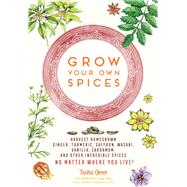Unlike herbs, which consist of the green leaves of certain plants, spices come from the seeds, roots, bark, or berries of plants, which means growing, harvesting, and preparing spices is a lot more nuanced than growing leafy herbs. Start with easy-to-grow seed spices first, such as sesame seeds, fennel, and cumin, then graduate to more challenging spice varieties, such as star anise, cinnamon, and nutmeg.
Spices not only offer culinary flare, there’s also increasing evidence of their ability to fight inflammation and reduce various health risks. Medical usage tips from expert herbalist Lindsey Feldpausch are found throughout the book and offer well-researched advice on how to use homegrown spices to improve your well-being.
Regardless of whether you’re using spices as a health-boosting supplement or simply to power-up the flavor of your meals, purchasing spices is an expensive proposition. Why pay all that money when you can grow your own organic spices with the easy-to-follow advice found here?
In the pages of Grow Your Own Spices, you’ll learn:
- How to cultivate your own saffron, the world’s most expensive spice
- The best way to tend tropical spices, like ginger, turmeric, and cardamom, even if you live in a cold climate
- Easy-to-grow spices that are perfect for beginners
- The unique way certain spices, such as wasabi, cloves, and cinnamon, are grown and harvested
- How to cultivate root spices, including horseradish and chicory
- Tips for harvesting your own capers, mustard, sesame seeds, and even paprika








